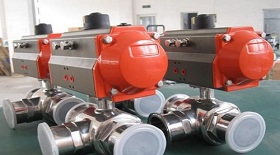Pneumatic valve standard
1. Valve body material should be mainly nodular cast iron, and indicate the brand and cast iron physical and chemical testing data.
2. Stem material strives for stainless steel stem (2CR13), and large caliber valve should also be stainless steel embedded valve stem.
3. Nut material uses cast aluminum brass or cast aluminum bronze, and the hardness and strength are greater than the stem.
4. Stem bushing material hardness and strength should not be greater than the stem, and in water immersion condition with the stem, valve body does not form electrochemical corrosion.
5. Material of sealing surface
(1) Different types of pneumatic valves, different sealing methods and material requirements.
(2) Ordinary wedge type gate valve, copper ring material, fixed mode and grinding method should be explained.
(3) Physical, chemical and hygienic testing data of soft sealing gate valves and valve plate lining materials.
(4) Butterfly valves should indicate the material of sealing surface on valve body and the material of sealing surface on butterfly plate. Their physical and chemical testing data, especially the hygienic requirements of rubber, anti-aging performance, wear resistance should be sure. It usually uses nitrile rubber and EPDM rubber, prohibitting the mixing of recycled rubber.
6. Valve shaft packing
(1) Because the pneumatic valves in the pipeline network are usually opened and closed infrequently, it is required that the packing should not be active for several years, and the packing should not be aged, so that the sealing effect can be maintained for a long time.
(2) Valve shaft packing should also bear good sealing effect when bearing frequent opening and closing.
(3) In view of the above requirements, the valve shaft packing should not be replaced for life or not replaced for more than 10 years.
(4) If the packing needs to be replaced, the design of the pneumatic valve should consider the replacement measures under the condition of water pressure.



